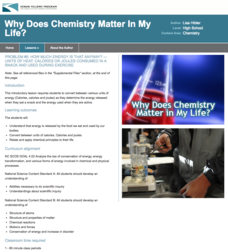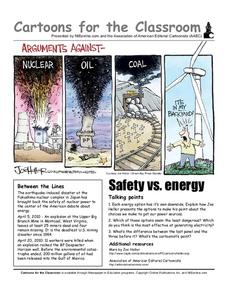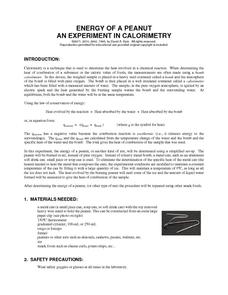Curated OER
Estimating Heat Changes during Reactions Using Bond Energies
For advanced chemists, this instructional activity examines heat change during chemcial reactions. Alkanes are examined first. Learners calculate the energy released or needed during a reaction.
Curated OER
Heat Energy Released or Absorbed in Chemical Reactions
Chemistry whizzes test the change in water temperature produced by a burning candle and the change in acid temperature produced by magnesium metal. With these two laboratory activities they explore heat produced during chemical...
NASA
Earth's Global Energy Budget
Introduce your earth science enthusiasts to the earth's energy budget. Teach them using an informative set of slides that include illuminating lecturer's notes, relevant vocabulary, embedded animations, colorful satellite maps, and a...
Curated OER
Bond Energies
Before completing this learning exercise, chemists are supposed read a portion of their textbook. Assign the chapter on bond energies, endothermic, and exothermic reactions. Then have your class answer the questions and fill in the data...
Kenan Fellows
How Much Energy Is That Anyway?
The fifth instructional activity in the six part series introduces units of energy including calories, Calories, and joules. Scholars determine the energy released when eating a snack and during activity.
Teach Engineering
Energy Forms, States and Conversions
Even magicians can't make energy disappear. In a discussion-based instructional activity, young scientists learn about energy forms and conversions. They see how energy is neither created nor destroyed; it just changes forms. This is the...
Teach Engineering
Energy Forms and States Demonstrations
Does a tennis ball have energy? What about a bowling ball? Demonstrate concepts of different forms of energy forms and states with a variety of objects. Using the equations for potential and kinetic energy, learners determine the amount...
Curated OER
Energy and Stoichiometry
In this stoichiometry worksheet, students calculate the amount of heat energy released in combustion equations. This worksheet has 4 problems to solve.
American Chemical Society
The Energy of Evaporation
Do all liquids evaporate at the same rate? Young scientists observe the evaporation rate of three different liquids. They measure the time, the temperature, and the change in energy. After comparing the chemical formulas, scholars...
Curated OER
Unit VII: Energy: Worksheet 2 Hooke's Law
Physic starters spring into energy with a problem-solving activity. They work with graphs, apply Hooke's law, draw force diagrams, and solve for distance, force, or mass in spring systems. There are seven problems in all.
Curated OER
Cycling of Matter and Energy
These twenty various types of questions related to the cycling of matter and energy require students to match each definition in column 1 with the correct vocabulary term from column 2. Then, students explain what is being demonstrated...
Curated OER
Cartoons for the Classroom: Safety vs. Energy
Political cartoons are a poignant way to examine energy sources. This analysis handout has scholars examining a cartoon by Joe Heller (a link to his gallery is included for possible extensions). Background information reminds pupils of...
Cornell University
Energy Changes in Chemical Reactions
The heat of solution measures how much thermal energy a dissolving substance consumes or gives off. The experiment demonstrates both endothermic and exothermic reactions. Scholars dissolve several substances, measure the temperature...
Chymist
Energy of a Peanut
Are you nuts? An engaging experiment burns nuts to find their kilocalories. Young chemists analyze at least two different types of nuts with their experimental results versus what is on the package. The resource offers a great lab for...
University of Georgia
The Power of Peanuts
Measure the amount of energy in a peanut by igniting a chemical reaction. Classes use a laboratory setup to burn a peanut and measure the amount of heat it releases through a temperature analysis. They calculate the number of Joules of...
Serendip
How Do Biological Organisms Use Energy?
When an organism eats, how does food become energy? Young biologists follow glucose through the process of cellular respiration to the creation of ADP using a discussion-based activity. The resource also highlights conservation of mass...
University of Georgia
Energy Content of Foods
Why do athletes load up on carbohydrates the evening before a competition? The lesson plan helps answer this question as it relates the type of food to the amount of energy it contains. After a discussion, scholars perform an experiment...
Curated OER
Energy for Earth: The Sun
Super science learners examine the sun's production of energy by the process of nuclear fusion. Hands-on activities make this lesson engaging for middle schoolers. The lesson is made up of four parts. Part I is an introduction to the sun...
Curated OER
Transfer of Thermal Energy
Students define temperature and heat, distinguish between temperature and heat flow, calculate amount of heat energy released or absorbed in chemical process, and design procedure, through experimentation, to gather and evaluate data to...
Curated OER
Window Treatments for Energy Savings
Students participate in an activity in which they determine which rooms are the warmest and coldest and explain why that is the case. They identify the types of energy saving window treatments and list their advantages and disadvantages.
Curated OER
Energy
All work and no play make Jack a dull boy, while all text and no graphics make Energy a dull presentation. It is informative, teaching viewers about work, conservation of energy, and sources that can be used to generate electricity. It...
Serendip
How Do Muscles Get the Energy They Need for Athletic Activity?
Every muscle movement requires energy, but where does that energy come from? Scholars answer this question and more as they complete a worksheet. By following the directions, completing research, and discussing it as a class, they begin...
Science Matters
Peanut Energy
How do humans get energy since they aren't mechanical and can't photosynthesize? Learners explore this question by relating potential energy in food to human energy levels. Scholars measure the change in mass and a change in temperature...
Curated OER
Energy and Energy Conversion
Third graders investigate different energy conversions through hands-on activities. In this energy lesson plan, 3rd graders move through four stations and conduct experiments illustrating energy conversions. Wave energy, chemical energy,...

























